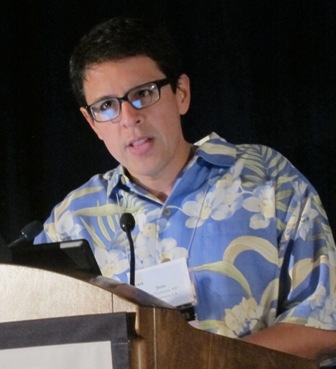User login
SCOTTSDALE, ARIZ. – Morbidity increased with the use of more than 5 L of crystalloid solution during high-ratio hemostatic resuscitation, according to the results of a retrospective study of 451 trauma patients.
This is the first multicenter analysis to demonstrate the deleterious effect on morbidity in high-ratio resuscitation (HRR) patients, Dr. Juan Duchesne said at the annual scientific assembly of the Eastern Association for the Surgery of Trauma.
"These patients already have acute insult, so when you add the double-hit phenomenon of crystalloids, you are definitely jeopardizing their outcomes," said Dr. Duchesne, director of the surgical intensive care unit at Tulane University, New Orleans.
The retrospective analysis included 451 patients treated at five centers in the United States. All received at least 10 units of packed red blood cells (PBRC) over 24 hours and damage control laparotomy. Of these, 365 received fresh frozen plasma (FFP) and PRBC at a ratio of at least 1:2 (HRR); the ratio was less than 1:2 (low-ratio resuscitation) in the other 86 patients.
The average Injury Severity Score was 23.5 (on a scale of 0-75), and the average FFP:PRBC ratio was 1.06 in the HRR group and 1.32 in the low-ratio resuscitation group.
As observed in other studies, patients in the HRR group had a significant survival advantage over those in the low-resuscitation group at 24 hours (85% vs. 69%; P = .0004), Dr. Duchesne said.
In 200 HRR patients with full data, an analysis of 24-hour crystalloid volume revealed that 9.5% received less than 5 L, 25% got 5-10 L, and 65.5% got more than 10 L. The 24-hour crystalloid volume was statistically different between the three subgroups (3.64 L vs. 7.81 L vs. 17.82 L; P = .0001), but there were no statistically significant differences in mortality.
The risk of certain morbidities, however, increased with crystalloid volume in the three subgroups. Rates of bacteremia rose significantly (0% [less than 5 L]), 13% [5-10 L], and 29% [more than 10 L]; P = .029), as did sepsis (0% [less than 5 L], 13% [5-10 L], and 22% [more than 10 L]); P = .028).
The differences were not significant for acute respiratory distress syndrome (1% [less than 5 L], 0% [5-10 L], and 8% [more than 10 L]; P = .163) and for acute respiratory failure (2% [less than 5 L], 12% [5-10 L], and 24% [more than 10 L]; P = .457).
In multiple logistic regression analysis, morbidity was significantly associated with 24-hour crystalloid volume (odds ratio, 1.11; P = .001), systolic blood pressure level in the emergency department (OR, 1.19; P = .043), and base deficit level in the emergency department (OR, 1.02; P = .002). Morbidity was not associated with high ratio resuscitation (OR, 1.34; P = .065), Dr. Duchesne observed.
Dr. Duchesne reported having no disclosures.
 |
Patrice Wendling/IMNG Medical Media
|
This study elucidates the tangible evils of crystalloid. Despite more than a decade of research pointing to concern about overuse of these solutions, some practitioners have been slow to come around. But as I look at this study, I question why the choice was to focus on the sickest of the sick.
I readily acknowledge that morbidity will have its worst effects on those most susceptible, thus increasing the power of the findings, but I am curious about the decision on those patients.
Further, 100% data capture for all items analyzed was only possible for 451 patients out of 1,484 patients who received at least one unit of packed red blood cells with massive transfusion protocol activation. Thus, a high number of patients were excluded from the study, raising the possibility of erroneous conclusions due to missing data.
The increase in morbidity associated with crystalloids would likely not have been observed if the cohort included all mass transfusion patients, and eliminated the Injury Severity Score and damage control laparotomy criteria.
Dr. Donald Jenkins, is past president of the Eastern Association for the Surgery of Trauma and is with the Mayo Clinic in Rochester, Minn. He was the invited discussant for the study at the meeting and reported having no disclosures.
 |
Patrice Wendling/IMNG Medical Media
|
This study elucidates the tangible evils of crystalloid. Despite more than a decade of research pointing to concern about overuse of these solutions, some practitioners have been slow to come around. But as I look at this study, I question why the choice was to focus on the sickest of the sick.
I readily acknowledge that morbidity will have its worst effects on those most susceptible, thus increasing the power of the findings, but I am curious about the decision on those patients.
Further, 100% data capture for all items analyzed was only possible for 451 patients out of 1,484 patients who received at least one unit of packed red blood cells with massive transfusion protocol activation. Thus, a high number of patients were excluded from the study, raising the possibility of erroneous conclusions due to missing data.
The increase in morbidity associated with crystalloids would likely not have been observed if the cohort included all mass transfusion patients, and eliminated the Injury Severity Score and damage control laparotomy criteria.
Dr. Donald Jenkins, is past president of the Eastern Association for the Surgery of Trauma and is with the Mayo Clinic in Rochester, Minn. He was the invited discussant for the study at the meeting and reported having no disclosures.
 |
Patrice Wendling/IMNG Medical Media
|
This study elucidates the tangible evils of crystalloid. Despite more than a decade of research pointing to concern about overuse of these solutions, some practitioners have been slow to come around. But as I look at this study, I question why the choice was to focus on the sickest of the sick.
I readily acknowledge that morbidity will have its worst effects on those most susceptible, thus increasing the power of the findings, but I am curious about the decision on those patients.
Further, 100% data capture for all items analyzed was only possible for 451 patients out of 1,484 patients who received at least one unit of packed red blood cells with massive transfusion protocol activation. Thus, a high number of patients were excluded from the study, raising the possibility of erroneous conclusions due to missing data.
The increase in morbidity associated with crystalloids would likely not have been observed if the cohort included all mass transfusion patients, and eliminated the Injury Severity Score and damage control laparotomy criteria.
Dr. Donald Jenkins, is past president of the Eastern Association for the Surgery of Trauma and is with the Mayo Clinic in Rochester, Minn. He was the invited discussant for the study at the meeting and reported having no disclosures.
SCOTTSDALE, ARIZ. – Morbidity increased with the use of more than 5 L of crystalloid solution during high-ratio hemostatic resuscitation, according to the results of a retrospective study of 451 trauma patients.
This is the first multicenter analysis to demonstrate the deleterious effect on morbidity in high-ratio resuscitation (HRR) patients, Dr. Juan Duchesne said at the annual scientific assembly of the Eastern Association for the Surgery of Trauma.
"These patients already have acute insult, so when you add the double-hit phenomenon of crystalloids, you are definitely jeopardizing their outcomes," said Dr. Duchesne, director of the surgical intensive care unit at Tulane University, New Orleans.
The retrospective analysis included 451 patients treated at five centers in the United States. All received at least 10 units of packed red blood cells (PBRC) over 24 hours and damage control laparotomy. Of these, 365 received fresh frozen plasma (FFP) and PRBC at a ratio of at least 1:2 (HRR); the ratio was less than 1:2 (low-ratio resuscitation) in the other 86 patients.
The average Injury Severity Score was 23.5 (on a scale of 0-75), and the average FFP:PRBC ratio was 1.06 in the HRR group and 1.32 in the low-ratio resuscitation group.
As observed in other studies, patients in the HRR group had a significant survival advantage over those in the low-resuscitation group at 24 hours (85% vs. 69%; P = .0004), Dr. Duchesne said.
In 200 HRR patients with full data, an analysis of 24-hour crystalloid volume revealed that 9.5% received less than 5 L, 25% got 5-10 L, and 65.5% got more than 10 L. The 24-hour crystalloid volume was statistically different between the three subgroups (3.64 L vs. 7.81 L vs. 17.82 L; P = .0001), but there were no statistically significant differences in mortality.
The risk of certain morbidities, however, increased with crystalloid volume in the three subgroups. Rates of bacteremia rose significantly (0% [less than 5 L]), 13% [5-10 L], and 29% [more than 10 L]; P = .029), as did sepsis (0% [less than 5 L], 13% [5-10 L], and 22% [more than 10 L]); P = .028).
The differences were not significant for acute respiratory distress syndrome (1% [less than 5 L], 0% [5-10 L], and 8% [more than 10 L]; P = .163) and for acute respiratory failure (2% [less than 5 L], 12% [5-10 L], and 24% [more than 10 L]; P = .457).
In multiple logistic regression analysis, morbidity was significantly associated with 24-hour crystalloid volume (odds ratio, 1.11; P = .001), systolic blood pressure level in the emergency department (OR, 1.19; P = .043), and base deficit level in the emergency department (OR, 1.02; P = .002). Morbidity was not associated with high ratio resuscitation (OR, 1.34; P = .065), Dr. Duchesne observed.
Dr. Duchesne reported having no disclosures.
SCOTTSDALE, ARIZ. – Morbidity increased with the use of more than 5 L of crystalloid solution during high-ratio hemostatic resuscitation, according to the results of a retrospective study of 451 trauma patients.
This is the first multicenter analysis to demonstrate the deleterious effect on morbidity in high-ratio resuscitation (HRR) patients, Dr. Juan Duchesne said at the annual scientific assembly of the Eastern Association for the Surgery of Trauma.
"These patients already have acute insult, so when you add the double-hit phenomenon of crystalloids, you are definitely jeopardizing their outcomes," said Dr. Duchesne, director of the surgical intensive care unit at Tulane University, New Orleans.
The retrospective analysis included 451 patients treated at five centers in the United States. All received at least 10 units of packed red blood cells (PBRC) over 24 hours and damage control laparotomy. Of these, 365 received fresh frozen plasma (FFP) and PRBC at a ratio of at least 1:2 (HRR); the ratio was less than 1:2 (low-ratio resuscitation) in the other 86 patients.
The average Injury Severity Score was 23.5 (on a scale of 0-75), and the average FFP:PRBC ratio was 1.06 in the HRR group and 1.32 in the low-ratio resuscitation group.
As observed in other studies, patients in the HRR group had a significant survival advantage over those in the low-resuscitation group at 24 hours (85% vs. 69%; P = .0004), Dr. Duchesne said.
In 200 HRR patients with full data, an analysis of 24-hour crystalloid volume revealed that 9.5% received less than 5 L, 25% got 5-10 L, and 65.5% got more than 10 L. The 24-hour crystalloid volume was statistically different between the three subgroups (3.64 L vs. 7.81 L vs. 17.82 L; P = .0001), but there were no statistically significant differences in mortality.
The risk of certain morbidities, however, increased with crystalloid volume in the three subgroups. Rates of bacteremia rose significantly (0% [less than 5 L]), 13% [5-10 L], and 29% [more than 10 L]; P = .029), as did sepsis (0% [less than 5 L], 13% [5-10 L], and 22% [more than 10 L]); P = .028).
The differences were not significant for acute respiratory distress syndrome (1% [less than 5 L], 0% [5-10 L], and 8% [more than 10 L]; P = .163) and for acute respiratory failure (2% [less than 5 L], 12% [5-10 L], and 24% [more than 10 L]; P = .457).
In multiple logistic regression analysis, morbidity was significantly associated with 24-hour crystalloid volume (odds ratio, 1.11; P = .001), systolic blood pressure level in the emergency department (OR, 1.19; P = .043), and base deficit level in the emergency department (OR, 1.02; P = .002). Morbidity was not associated with high ratio resuscitation (OR, 1.34; P = .065), Dr. Duchesne observed.
Dr. Duchesne reported having no disclosures.
AT THE EAST SCIENTIFIC ASSEMBLY
Major finding: With a rise in the volume of crystalloid solutions, rates of sepsis rose significantly (0% [less than 5 L], 13% [5-10 L], 22% [more than 10 L]); P = .028).
Data source: Retrospective multicenter analysis of 451 patients undergoing hemostatic resuscitation.
Disclosures: Dr. Duchesne and Dr. Jenkins reported having no disclosures.

